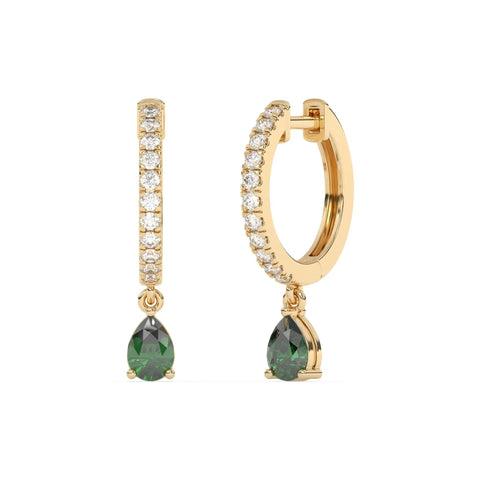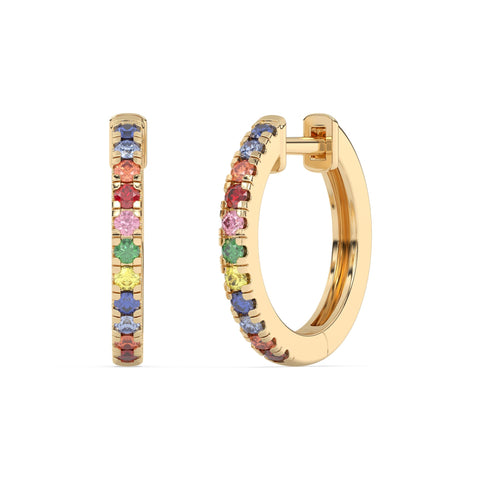Understanding the four C's of Coloured Gemstones
Coloured gemstones have a beauty and character all of their own, offering endless variety beyond the sparkle of a diamond. The question I'm always asked is how do you know if you're looking at a truly great gem or ones that's all hype and no substance.
The 4 Cs of Coloured Gemstones: What You Really Need to Know
When it comes to grading coloured gemstones, one thing stands out above all else: colour is king. Unlike diamonds, where brilliance and clarity reign supreme, the most important thing to focus on when choosing a ruby, sapphire, emerald or any other gemstone is its hue, tone and saturation in other words, the quality of its colour.
At Argent & Asher, I’ve always been drawn to vivid colour. I love the depth, the drama, and the emotion that coloured gemstones bring to a piece of jewellery. It’s why I go to such lengths when sourcing our stones, always looking for those rich, vibrant hues that speak to the heart. I also love mixing coloured gemstones with diamonds; that combination of sparkle and colour is just magic to me.
If you’re considering a piece of jewellery with coloured gemstones whether it’s a bespoke creation or one of our signature pieces like our Emerald 6 Stone Ring or Rainbow Tennis Necklace, understanding the 4 Cs will help you choose wisely and appreciate what makes each gem truly special.
In this guide, we’ll walk you through the 4 Cs of coloured gemstones, colour, cut, clarity, and carat, and how they differ from diamond grading.

What Are the 4 Cs of Coloured Gemstones?
You’ve probably heard of the 4 Cs in the context of diamonds: Cut, Colour, Clarity, and Carat. These same factors also apply to coloured gemstones, but with some key differences. Here’s how they break down:
- Colour (The Star of the Show) In coloured gemstones, colour isn’t just one factor, it’s the most important. It affects both the beauty and the value of the gem more than any other element.
The Three Components of Colour:
- Hue: The basic colour—blue, green, red, etc.
- Tone: How light or dark the colour appears.
- Saturation: The intensity or purity of the colour.
The most desirable coloured gemstones usually have:
- Pure hues (like deep royal blue sapphires or rich ruby reds)
- Medium to medium-dark tones
- Vivid or intense saturation
Our Take: When I’m sourcing gemstones, I look for that immediate emotional pull—the wow factor. I’m obsessed with stones that almost glow with colour. It’s this vividness that makes them come alive in a piece of jewellery.
Colour Intensity Scale (as used by ICL):
- Vivid – The most prized, optimal combination of tone and saturation
- Intense
- Medium Intense
- Deep
- Dark
- Light
- Very Light
Check out our bespoke jewellery page if you’re dreaming of a piece centred around a particularly stunning colour, we can help you find your perfect stone.

2. Cut (Bringing Out the Best in the Stone)
Cutting coloured gemstones is as much an art as it is a science. Unlike diamonds, where cut is about sparkle, with gemstones it’s about showcasing the best colour possible.
Why Cut Matters:
- Enhances colour by affecting how light moves through the stone
- Minimises visible inclusions
- Retains carat weight from rare rough stones
- Highlights unique features, like colour zoning or optical effects
Common Gemstone Cuts:
- Brilliant Cut (for sparkle)
- Step Cut / Emerald Cut (often used for emeralds to reduce stress on the stone)
- Cabochon (smooth, domed shape for opaque or translucent stones)
Our Take: I especially love cutting styles that show off a stone’s individuality—like the way a cushion-cut sapphire can look softer and more romantic, or how a step-cut emerald just screams timeless luxury.

3. Clarity (Embrace the Inclusions)
Unlike diamonds, inclusions in coloured gemstones are often expected—and sometimes even celebrated.
Clarity Types (GIA’s Classification):
- Type I: Usually eye-clean (e.g. aquamarine, blue topaz)
- Type II: May have visible inclusions (e.g. sapphire, ruby)
- Type III: Almost always included (e.g. emeralds)
ICL Grading Levels:
- Eye Clean (EC1–EC2) – No visible inclusions to the naked eye
- Visible Inclusions (VI1–VI2) – Minor inclusions visible
- Included (I1–I2) – Obvious inclusions
Our Take: I actually think inclusions give a gemstone soul. They tell a story about where the stone came from, like a fingerprint from the Earth. When it comes to emeralds, I’ll always choose rich colour with some inclusions over a clean but lifeless stone.
4. Carat (Size Still Matters… Sometimes)
Carat refers to a gemstone’s weight, not its size. Because different gems have different densities, two stones of the same carat can look very different in size.
- Why Carat Is Important:
- Larger stones are rarer and often exponentially more valuable
- Certain gemstones (like rubies and emeralds) are extremely rare above 1–2 carats
Some colours and hues look better in larger sizes, especially pastel tones
Our Take: One of my favourite things is sourcing unusually large, vibrant coloured gems that are still wearable and elegant. There’s something show-stopping about a ring with a bold centre stone that catches the light and holds your gaze.
Also Read: A Pop of Colour: How to incorporate Rainbow Jewellery into your everyday wardrobe
Other Factors That Influence Value
While the 4 Cs are crucial, there are a few other things that can affect a coloured gemstones' beauty and worth:
Origin
Gemstones from certain regions are more valuable due to rarity and prestige:
- Burmese rubies
- Kashmir sapphires
- Colombian emeralds

Treatment
Many coloured gems are treated to improve colour or clarity. The most common method is heat treatment, which is industry-standard and accepted. However, untreated gemstones with top qualities are significantly more valuable.
At Argent & Asher, we prioritise natural and responsibly sourced stones. We work closely with our partners to ensure ethical practices, and we’re transparent about whether a stone has been treated.
Shape & Style
Gemstones can be cut into nearly any shape, and while shape doesn’t affect price, it does influence how a stone looks and feels in a piece of jewellery.
Our Take: I love playing with shape and layout when designing custom pieces, especially when mixing diamond accents with a pop of colour. It’s one of the reasons our Rainbow Tennis Necklace has been such a hit: it’s joyful, vibrant, and tells a colourful story through every stone.
Our Favourite Coloured Gemstone
Picks Here are a few Argent & Asher pieces that showcase the magic of the 4 Cs in real life:
Emerald 6 Stone Ring
A celebration of symmetry, colour and clarity. The lush green of these emeralds contrasts beautifully with the gold setting, an elegant nod to vintage glamour.

Rainbow Tennis Necklace
This piece brings together sapphires, emeralds, and diamonds in a joyful cascade of colour. It’s bold, bright, and guaranteed to be a talking point.
Custom Creations – Bespoke Jewellery
If you have a favourite gemstone, or even just a colour you love, we can help you create a piece that’s completely unique to you. Whether it’s a vivid ruby pendant or a birthstone bracelet with a secret meaning, the possibilities are endless.
Final Thoughts from Argent & Asher
Coloured gemstones are personal. They’re emotional. And they’re incredibly special.
Whether you’re drawn to the electric green of emeralds or the sunset hues of sapphires, knowing the 4 Cs empowers you to choose a piece that resonates with you—and that will stand the test of time.
As a designer, there’s nothing more rewarding than seeing someone fall in love with a gemstone. It’s not just about aesthetics, it’s about storytelling, memory-making, and creating something you’ll cherish for a lifetime.
So if you’re ready to explore the world of coloured gemstones, we’re here to help you find that perfect stone.
Start your bespoke journey here
Or explore our colourful collections today
Related Articles
Which Gemstones Are Right for Your Stud Earrings?
There’s a reason studs are a jewellery staple: they just make sense.
The beauty of it all? You get to decide which feels right for you. And if you’re not sure, we’ll walk you through it.
Stud Earrings: Shapes, Styles, and Backs Explained
You can’t really go wrong with a good pair of stud earrings.
Here, we’ll take you through what makes them such a smart choice and how to find the ones that feel like “you” by explaining the shapes, styles, and backs.
What Are Toi et Moi Rings?
Have you ever come across a toi et moi ring? The name means “you and me” in French, and it’s just as romantic as it sounds. It’s the sort of ring that tells a story, which is probably why people love giving it for engagements and anniversaries.
The Meaning Behind the Two Stones in Toi et Moi Rings
Toi et Moi, French for “You and Me”, is such a sweet name for a ring, isn’t it? These designs feature two stones, sitting side by side, to represent two people joined together.
It’s a lovely, symbolic style, a bit more personal than the classic single-stone ring. Whether it’s for a proposal, an anniversary, or just a special occasion, it says: “It’s us. Together.”
Join us as we explore the meaning behind the two stones in toi et moi rings.







